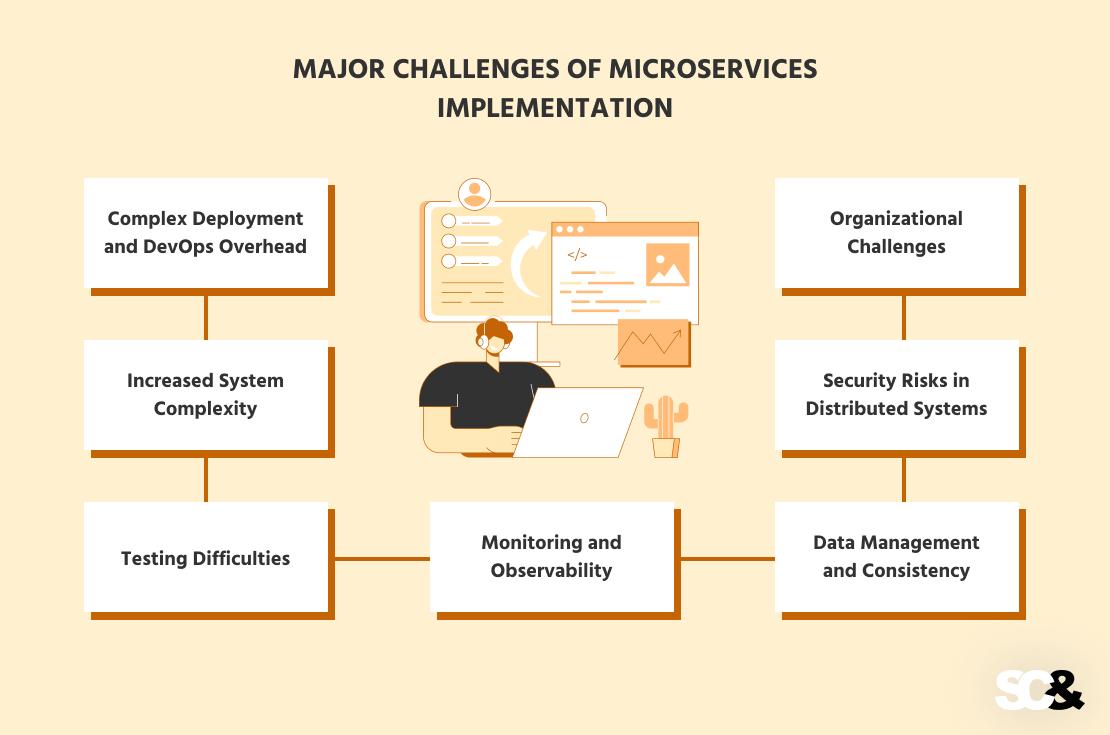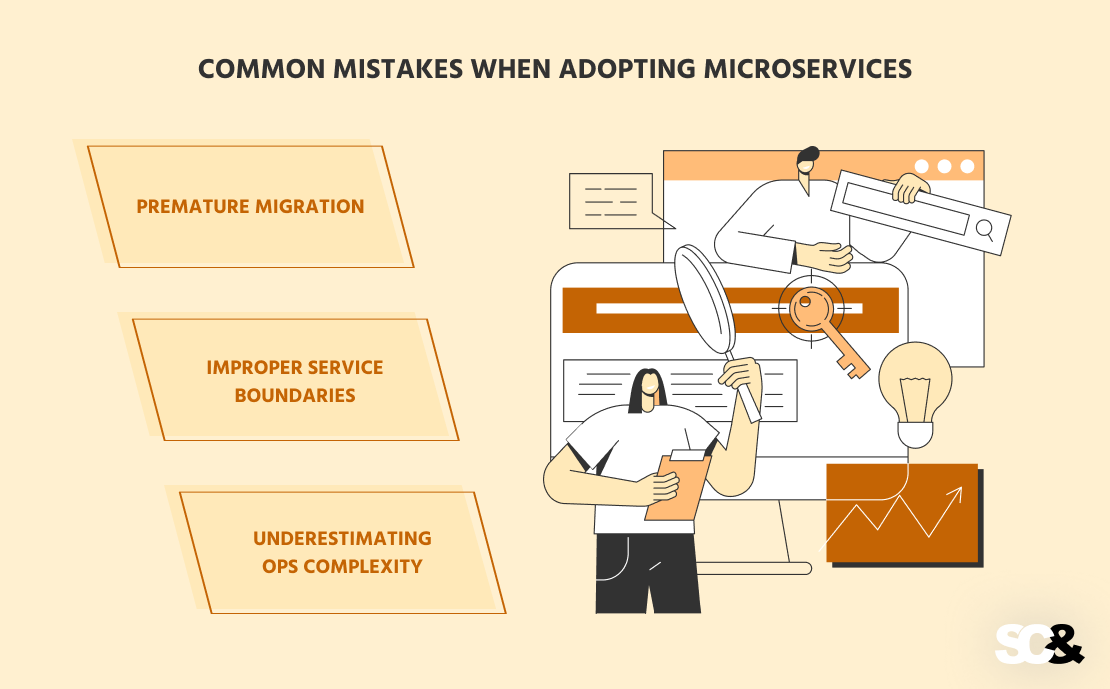Table of Contents
Adopting a microservice architecture opens up many opportunities for businesses, from flexibility in development to scalability and reliability. However, this approach is not only associated with benefits, but also with a number of significant challenges.
From technical nuances to organizational changes, it’s important to understand the potential complexities for the transition to be successful. Below, our team has prepared a list of key challenges companies face when using microservices.
How Microservices are Already Making Life Easier For Users and Companies
Imagine ordering food through a mobile application. You choose your meal, pay for the order, track the delivery on a map, and get a notification when the deliveryman arrives.

Everything looks like a single service, but in fact, there is a whole set of separate, independent systems behind it: one of them processes orders, another works with the menu, a third with payment, a fourth with logistics, and a fifth is responsible for push notifications. This is a microservice in action.
Each of these units works autonomously. If, for example, the notification system fails temporarily, you will still be able to order and pay for food. And if the company decides to introduce a new payment system or update logistics, you can do this without touching the rest of the functionality.
This approach makes the service more flexible, reliable, and user-friendly. What is even more important is that it is profitable for business: changes can be implemented quickly, and the risks of the entire system breaking down are minimized.
What is Microservice Architecture?
Microservice architecture is a way of organizing a digital product in which an application consists of many small, independent components. Each of them solves a strictly defined task and can work independently of the others. This is the opposite of the traditional approach, when the entire application is assembled “in one piece” — like a monolith.

In a traditional monolithic system, all functions are interconnected, and the slightest change can affect the entire system. This is convenient at the product launch stage, but becomes a problem when the project grows: any update takes time, the risk of failures increases, and scaling becomes more difficult.
Why Microservices: Key Benefits
Companies start thinking about moving to a microservices system when they face growth, increasing complexity of business logic, or the need to make frequent changes.
For example, if you are developing an online store and want to quickly add new payment methods, automate delivery, and connect third-party services, a microservice approach will give you the flexibility you need. It allows you to scale only those parts of the product that really need it, avoiding overconsumption of resources.
Development teams can work in parallel on different components without interfering with each other, and launch new features in stages without the risk of “dropping” the entire service.
For businesses, microservices architecture is about adaptability, speed of change, and technological sustainability. It’s not just a question of “how to build an app”, but a strategic decision that affects the efficiency of digital product development.
Major Challenges of Microservices Implementation
While multiple services offer great opportunities for flexibility and scalability, there are a number of practical and organizational challenges in moving to this architecture. The following are the key challenges companies face when implementing a microservice approach.

1. Complex Deployment and DevOps Overhead
Each microservice is a separate component that needs to be customized, deployed, and updated. This requires advanced infrastructure: automated CI/CD processes, container management (e.g., via Kubernetes), version control, and compatibility between services. All this increases the technical burden and requires well-built DevOps processes.
2. Increased System Complexity
Microservices create a distributed architecture where many components communicate with each other through a network. This creates new challenges: how to organize stable data transfer between services, how to ensure fault tolerance, and how to synchronize data, especially under high loads.
3. Testing Difficulties
Testing of microservices is not only testing the code of each individual service, but also the whole bundle of them. This brings up the many types of testing that need to be done for a comprehensive functionality check: integration tests, contract tests, and the need to mock the behavior of other services. All this increases the time and resources required for QA processes.
4. Monitoring and Observability
To control the operation of dozens (and sometimes hundreds) of microservices, you need systems for monitoring, logging, request tracing, and alerting. It is important to track where exactly a failure occurred and how it affected other services. Tools like Prometheus, Grafana, and Jaeger are actively used here.
5. Data Management and Consistency
Unlike a monolithic application, where all data can be stored in a single database, microservices often use different databases. This makes it difficult to maintain data integrity and requires special approaches such as eventual consistency, distributed transactions, or Saga-type templates.
6. Security Risks in Distributed Systems
Each microservice must be protected, both at the level of interaction with other services and in the external API. For this reason, authorization and authentication mechanisms are implemented (e.g., JWT, OAuth), and access is organized through API gateways. Without centralized control, the risk of errors in security configuration increases.
7. Organizational Challenges
The microservice approach requires team restructuring: moving from vertical departments to cross-functional teams, each responsible for its service. This demands new principles of interaction, a clear zone of responsibility, and synchronization between departments so that the architecture does not develop chaotically.
Common Mistakes When Adopting Microservices
The transition to microservice architecture can provide businesses with tangible benefits, but only if implemented correctly. Unfortunately, many companies make similar mistakes that lead to higher project costs, slower development, and loss of control. Below are three of the most common ones.

Premature Migration
One of the most common mistakes is trying to move to microservices too early, when the product has not yet reached the right level of maturity. Implementing a microservice architecture requires serious preparation and is justified only when scalability, flexibility, and high speed of change are really necessary. Otherwise, microservices complicate the system without any real benefit.
Improper Service Boundaries
A mistake at the service design stage can lead to chaos in the architecture. If services are separated “by convenience” rather than by business logic, duplication, over-dependency, and inefficient communication between parts of the system occur. It is important that each microservice reflects a specific business function and is as autonomous as possible.
Underestimating Ops Complexity
Many people think that microservices are simply “splitting a monolith into parts”. But in practice, this means building a complex infrastructure: CI/CD, monitoring, security, and fault tolerance. Without mature DevOps processes and experience in building distributed systems, the migration can lead to instability and technical debt.
When Not to Use Microservices
Microservice technology is a powerful tool, but its implementation is not justified in all cases. According to an O’Reilly study, only 13% of companies reported complete success after adopting microservices. The majority (about 50%) rate the result as “mostly successful,” while nearly a quarter report limited or no success. This underscores the point: microservices only deliver results when they are applied consciously and with the project context in mind.

Evaluation of the success of microservices implementation according to O’Reilly data
Implementing microservices can seriously complicate the work, especially if the team is small or the product is at an early stage, such as the MVP phase. At this stage, speed of launch, simplicity of architecture, and minimal support costs are critical. Splitting into dozens of services that require separate configuration, testing, and monitoring will only slow down the process and will not provide tangible business benefits.
Microservices are also inappropriate for projects with no need for scaling. If the product is highly specialized, with limited functionality and stable load, a classic monolithic architecture will be simpler, more reliable, and cost-effective. Microservices require mature DevOps processes, automation, monitoring tools, and close coordination between teams.
If these conditions are not met, and architectural complexity is not compensated by the scale of the business, it is better to focus on simplicity and efficiency rather than trends.
Best Practices to Overcome These Challenges
To implement microservice architecture as effectively as possible and avoid common mistakes, it is important to use proven approaches, both at the technical and organizational levels. Below are the key practices that help companies successfully cope with the challenges of the microservice approach.
Utilizing Thoughtful Design Patterns
Patterns such as API Gateway, Circuit Breaker, and Service Mesh make it easier to manage large numbers of services.
- Gateway API serves as a single point of entry for all client requests and provides security, routing, and data aggregation.
- Circuit Breaker helps avoid cascading failures — if one service is unavailable, requests are temporarily redirected or blocked.
- Service Mesh enables you to manage interactions between services in a centralized way, including security, monitoring, and traffic control.
Moving to Event-driven Architecture and Message Brokers
Event-driven architecture allows services to interact through events rather than directly. This reduces dependencies between components and simplifies scaling.
Using systems such as Kafka or RabbitMQ helps to transfer data reliably and asynchronously, especially useful under high loads and when large amounts of data need to be processed.
Establishing Clear SLAs Between Services
Each microservice should have clear boundaries of responsibility and well-defined SLAs (service level agreements). This helps to align expectations between teams, reduce conflicts, and ensure predictability across the system.
Gradual Migration Strategy
A complete and abrupt transition from a monolith to microservices is one of the riskiest paths. It is much safer to use a step-by-step migration: first allocate critical functions, transfer them to separate services, stabilize them, and only then continue. This approach reduces risks and allows the team to adapt to the new format of work without losing quality and speed.

Real-World Use Case: Migrating to Microservices in Enterprise Software
One example of a successful migration to a microservice architecture is the SCAND project for a large corporate client. Initially, the system was implemented as a monolith, which made scaling difficult and slowed down the release of new features.
The SCAND team audited the architecture and proposed a phased transition strategy. Key business modules (authentication, document processing, notifications) were identified, each of which became an independent microservice.
This allowed the client to accelerate the implementation of changes, improve fault tolerance, and adapt the product to load growth, without risking the stable operation of the system.
Conclusion: Is Microservices Architecture Right for Your Project?
Microservice architecture is an excellent choice for scalable, technologically sophisticated solutions with active development. It provides flexibility, team independence, ease of upgrades, and a high level of resilience. However, in the case of small products or MVPs, microservices can be redundant, increasing complexity and support costs.
If you’re in doubt about whether this approach is right for your project, it’s important to weigh technical and business factors: growth objectives, team maturity, speed of development, and expected workloads. Contact us for help auditing your system.


